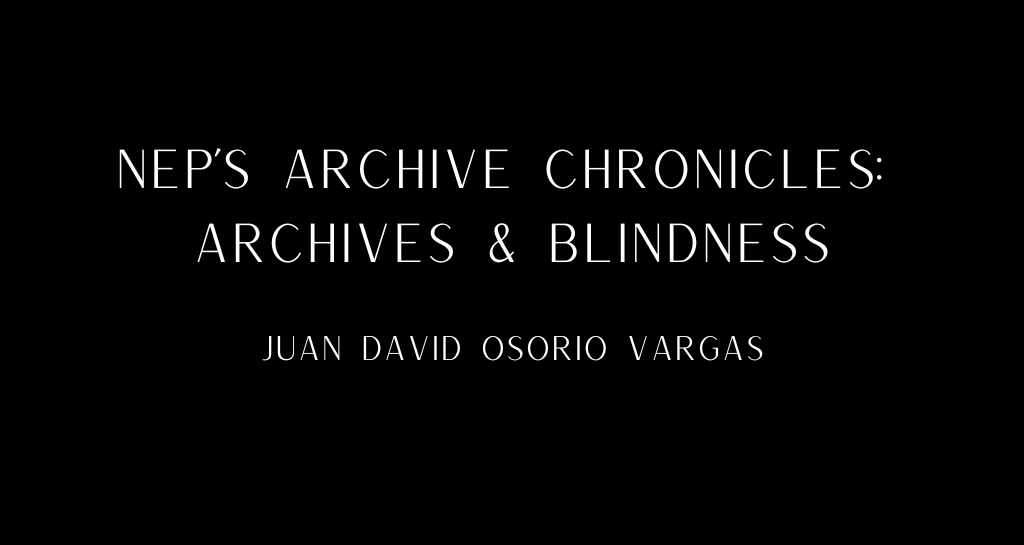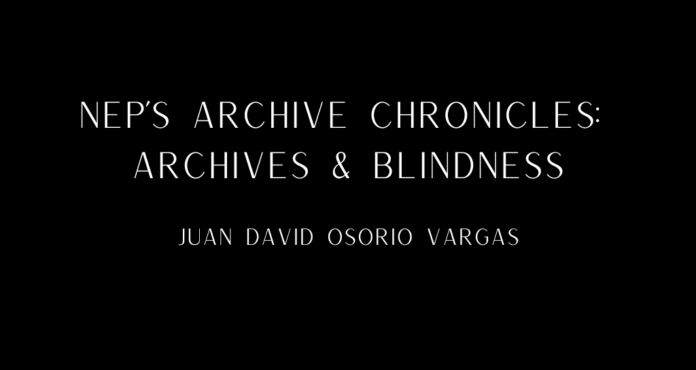
NEP’S Archive Chronicles explores the role archives play in historical research, offering insight into the process of conducting archival work and research. Each installment will offer a unique perspective on the treasures and challenges researchers encounter in archives around the world. NEP’s Archive Chronicles is intended to be both a practical guide and a space for reflection, showcasing contributors’ experiences with archival research. In this installment of NEP’s Archive Chronicles, published in English and Spanish, Juan David Osorio Vargas explores the connection between archives and blindness.
Nota: Haz click aquí para acceder a la versión en español.
Note: Click here to access Spanish version.
Jacques Derrida tells us that fundamentally there are two types of experiences.[1] One of them is anchored in the present and refers to what we can balance with our eyes. In this case, one of the functions of the eye is to foresee, to anticipate the unknown or the presence of the other. This constitutes one of the two possible experiences. The other, which I wish to explore in this article, is the experience of blindness. It is the one that charts an unexpected, unpredictable, and open journey toward the heterogeneity of the other—the other that is there to surprise us. It is, precisely, a journey that cannot be programmed, a cartography of the indeterminate, devoid of purpose. It is the experience of the present that connects us to the uncertainty of a historical event.
As a blind historian, I am convinced that forms of knowledge organized through other senses are valuable in themselves. The question of whether a blind historian can access materials from the visual world is met with a clear yes. We can develop a language with these characteristics if we significantly expand the democratizing reach of the archive, as well as the questions surrounding it, through compensatory technologies that ensure the translation from one record to another does not lose its legitimacy.
To engage with the archive is to undergo the metaphorical experience of blindness. Not all historians possess the vision to anticipate what lies ahead, for some navigate the past without sight. The archive teaches us that every time we enter it, it becomes more uncontrollable and unfamiliar. If we consider the Derrida’s second concept of experience, we can recognize that the archive is a journey without an apparent horizon, directed toward what is not visible—an idea that closely aligns with the practice of being a historian.
I say that the archive is the experience of blindness because we cannot anticipate it. We do not know what will surprise us or through what new technology or which questions it will respond. Much has been said about the silence of archives and the erasures they contain, but little thought has been given to the quality of blindness that resides within them and the relationship it establishes with visibility.
Last summer, while conducting archival research in Colombia and Panama, I encountered this reality: being blind and experiencing blindness in a dual sense was not enough to navigate the archive, as speech itself structurally implies non-vision. And speech is my first point of contact with the archive. It seems that those familiar voices, unseen, are the immediate reality of their presence. I perceive words that might interest me. I ask a question and am met with silence. Once again, the archive is mute. My mother strains to find the word I am looking for in a document crumbling to dust, but she cannot see it either. We are left groping in the dark. We are blind.
I reflected on how that materiality could act and speak to me so that I could question it with my clues and intuitions. I perceived the archive as that inescapable device we must navigate to reach a place in the past or historical knowledge, much like I conceive of my cane, which allows me to feel out the unknown spaces I traverse each day. The nature of this experience is apprehension—the quality that enables movement between voice and archive, analogous to the coordinated relationship between hand and cane.
I consider the negotiations that grant access to the archive as technologies that help us comprehend what it reveals. They represent a kind of ancient anthropology of capturing the world, serving to reduce complexity or make the unfamiliar more accessible. These forms alleviate the estrangement caused by temporal distance and the impossibility of reading a testimony from the past through the biology of our eyes alone. These multiple technologies must be understood as constitutive parts of the networks of reading, interpretation, and labor that underpin the historian’s practice: voices that communicate traces, graphs, and imprints. We should allow the technologies surrounding the archive to speak as well, critically engaging with it. It is these voices—which remind me of those of my mother, my father, and my friends—that strive to make the archive speak within a complex network of questioning, response, and interpretation; a hermeneutic circle that creatively reinforces this experience of not seeing.
More than any contemporary technique related to mass digitization or the use of artificial intelligence, it is the proximity of the voice that brings the archive into presence and draws it closer to the life of both the reader and the listener. The absence of these mediations is palpable and dramatically evident in our archival architecture. The dominance of visuality seems to govern the historian’s practice, positively reinforcing the facts of the past: what is read is, and what the archive records is perceived as truth.
For those of us who cannot see, the archive appears the moment we access any institution that houses materials and bears its name. The archive is the entire material circuit that sustains it. Its inaccessibility is a tangible testimony of a past time, with its stairs designed for certain bodies, its locations in spaces that filter sound, and its predominantly visual environment—from the catalog to the reference materials, most of which are illegible to those who, like me, are not immersed in the visual logic.
The archive is inspired by the affections that make it speak after the unpredictable experience of blindness. Hence, to be without sight does not prevent us from questioning it and making it visible. Drawing on Derrida, this experience is a paradox of sight, where a radical disagreement emerges. Derrida invites us to think about the choice we make when we look at ourselves in the mirror: we must choose between looking at the color of our eyes or looking at the influence of the gaze we see. The archive also invites us to reflect on this paradox. We can limit ourselves to seeing what it tells us or trace the influence of its gaze in order to question and judge it critically through perspective. In either case, we do not need to begin with the eyes. The archive initially presents itself in total darkness; it is only later that the gaze emerges, carrying with it the full potential of the frame.
The paradox of this process lies in the fact that the gaze we use to examine the archive inherently requires a blind spot from the very beginning. What we illuminate must be surrounded by a zone of blindness, a boundary that excludes the intelligible from the rest. This zone of indeterminacy is the challenge faced by perspective: the vision of the gaze that, in framing, selects.
It is striking is that eyes are not necessary to complicate and give voice to the archive. The gaze is the point of view of selection—a sensory regime that organizes the relationship between seeing and not seeing, or, in other words, the theory that illuminates the blind spots of historical memory.
Intellectual history has taught us that ideas have been constructed around metaphors of vision.[2] We are permeated by their semantic and metaphorical weight. What I propose, inspired by Derrida, is to think about the act of not seeing, and I believe the archive allows us to explore this singularity. Blindness raises profound questions about the indeterminacy of history, guiding us toward research paths that must be navigated without a predefined map. For this reason, the compass of our anthropological framework urges us to value the nature of the question and the tentative response.
I believe that framing blindness as a methodological metaphor for the archive not only carries interpretative significance but also fosters a research agenda with transformative potential for archival scholarship. First, it reveals the sensory possibilities of materials from the past, reflecting an interdependence of the senses as forms of knowledge: touch, vision, hearing, and smell. Second, it broadens the notion of accessibility and the intended audiences of the archive, aligning with a democratizing perspective. And finally, it enables us to address the archive’s opacities through a more nuanced reading, formulating tentative questions, provisional answers, and new interpretations.
Deciphering the archive requires us to confront the paradox of vision and blindness. The challenge to ocularcentrism lies precisely in this paradox: we see without looking, and we look by selecting. What I propose here is to embrace the archive as an experience of blindness. Let us cover our eyes and receive it as an unknown and singular event—something that cannot be anticipated or perceived in advance. Let the experience of blindness offer us the possibility of engaging with the archive in all its complexity, interrogating it with every sense at our disposal. Let us approach it from the start as an unpredictable event, one that can never be fully exhausted or definitively grasped.
Juan David Osorio Vargas is a political scientist and historian pursuing a master’s degree in Latin American Studies at UT Austin. His research focuses on Latin American intellectual histories, disability histories, and body politics.
The views and opinions expressed in this article or video are those of the individual author(s) or presenter(s) and do not necessarily reflect the policy or views of the editors at Not Even Past, the UT Department of History, the University of Texas at Austin, or the UT System Board of Regents. Not Even Past is an online public history magazine rather than a peer-reviewed academic journal. While we make efforts to ensure that factual information in articles was obtained from reliable sources, Not Even Past is not responsible for any errors or omissions.
[1] Jacques Derrida, Thinking out of Sight. Writings on the Arts of Visible. The university Chicago Press, 2021, 35-36.
[2] Martin Hay, Downcast eyes. The Denigration of Vision in Twentieth-Century Thought French. University of California Press, 1993, 33.

